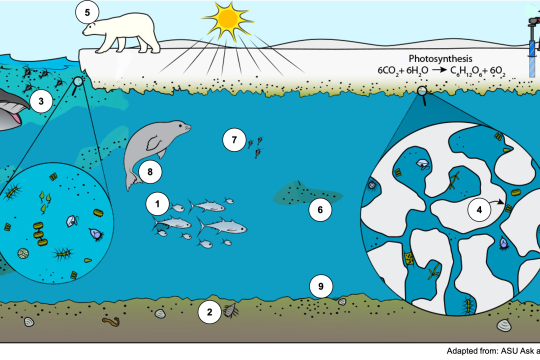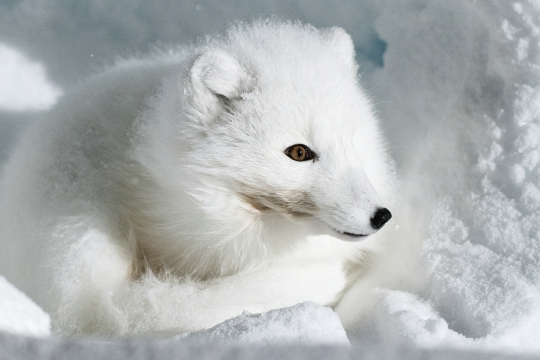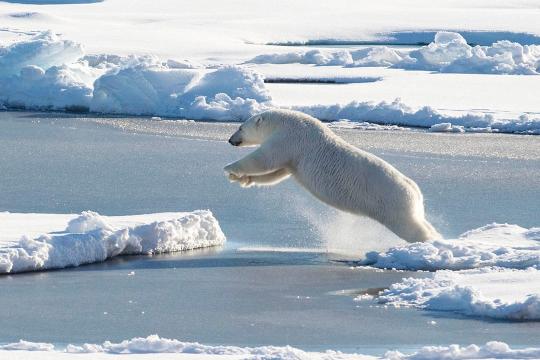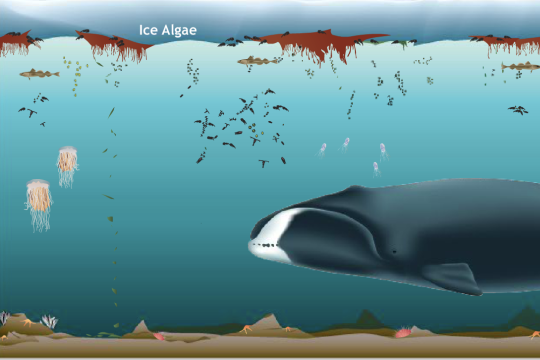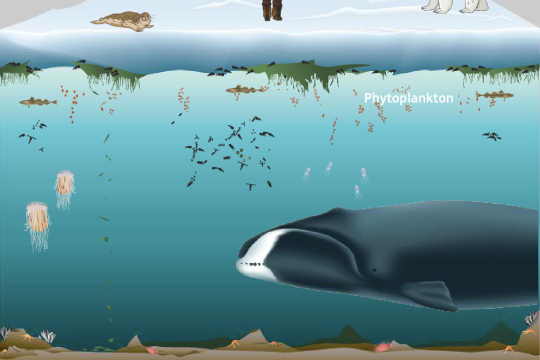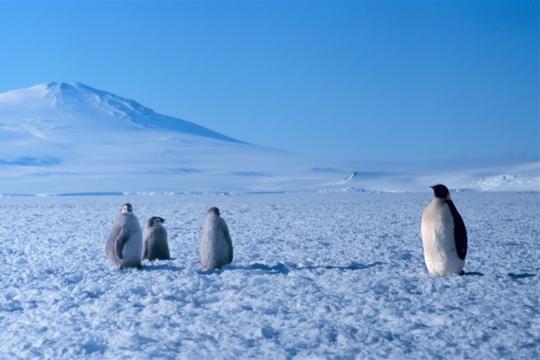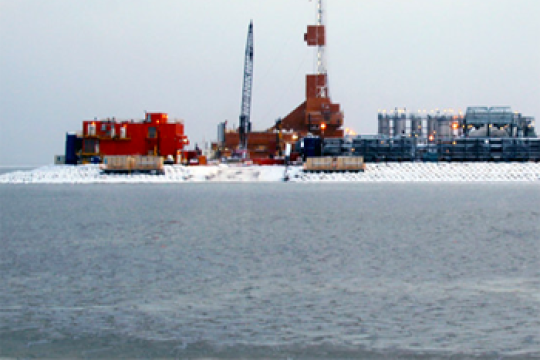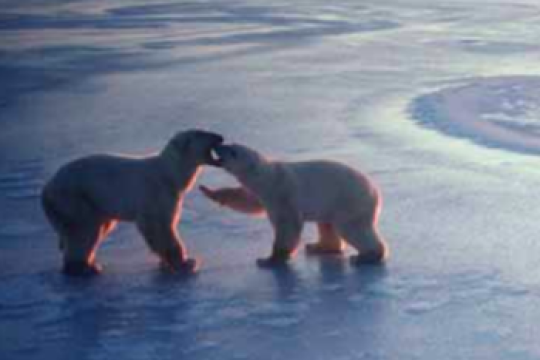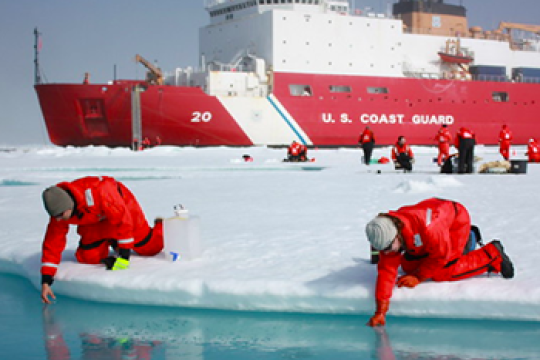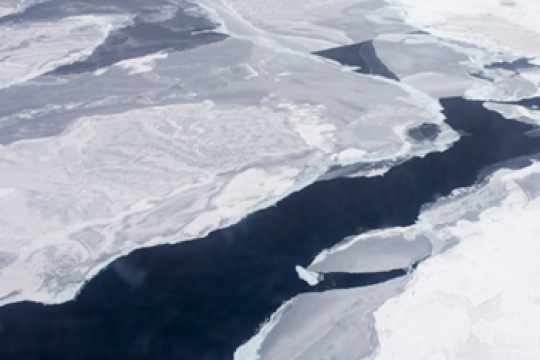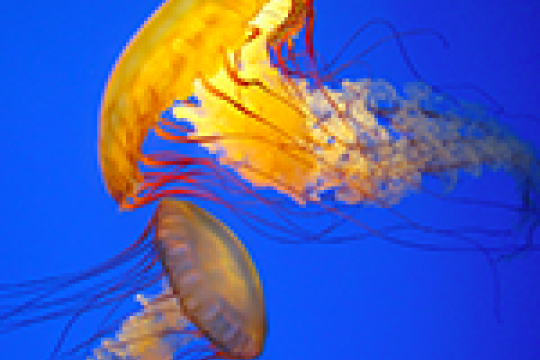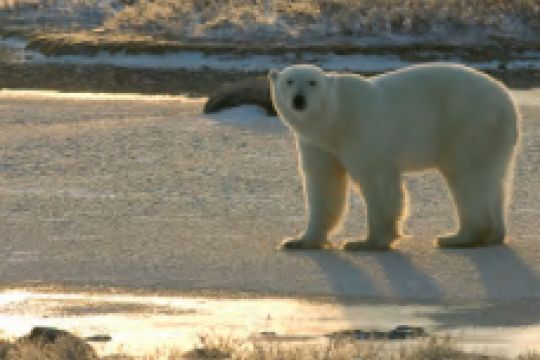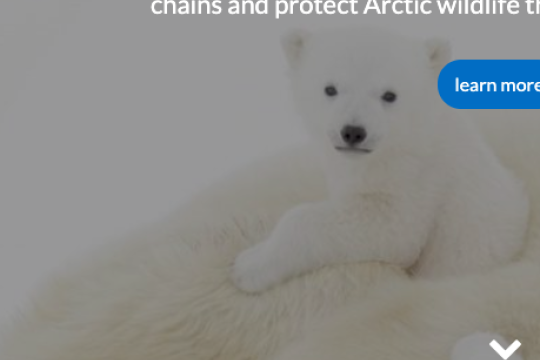Ecosystems
Quick Bite: Fill in the Food Web
What does an Arctic food web look like, and what are the relationships between its members? Find out in this Quick Bite activity.
Quick bite
Subject: Constructing explanations, Developing and using models, Ecosystems, Life science, mosaic monday, Polar Bears
Grade Level: 3-5, Middle School, High School
Developer: CIRES
What does an Arctic food web look like, and what are the relationships between its members? Find out in this Quick Bite activity.
Quick bite
Subject: Constructing explanations, Developing and using models, Ecosystems, Life science, mosaic monday, Polar Bears
Grade Level: 3-5, Middle School, High School
Developer: CIRES
Quick Bite: Arctic Adaptations
Did you know that some Arctic foxes change color depending on the season? In this Quick Bite activity, your students will hypothesize why this happens and what it means for the Arctic foxes' survival. Photo credit: Michael Ginzburg
Project of Mosaic Quick bite
Subject: Constructing explanations, Ecosystems, Life science, mosaic monday
Grade Level: 3-5, Middle School, High School
Developer: CIRES
Did you know that some Arctic foxes change color depending on the season? In this Quick Bite activity, your students will hypothesize why this happens and what it means for the Arctic foxes' survival. Photo credit: Michael Ginzburg
Project of Mosaic Quick bite
Subject: Constructing explanations, Ecosystems, Life science, mosaic monday
Grade Level: 3-5, Middle School, High School
Developer: CIRES
Know Your Ocean: Polar Research
Learn more about polar topics like glaciers and ice sheets, Arctic sea life, and sea ice in these polar research educational modules from the Woods Hole Oceanographic Institution.
Subject: Earth science, Ecosystems, Geography, Life science, Obtaining and evaluating information, Oceans and ocean circulation, Physical science, Sea ice
Grade Level: Middle School, High School, University/college, Adult
Learn more about polar topics like glaciers and ice sheets, Arctic sea life, and sea ice in these polar research educational modules from the Woods Hole Oceanographic Institution.
Subject: Earth science, Ecosystems, Geography, Life science, Obtaining and evaluating information, Oceans and ocean circulation, Physical science, Sea ice
Grade Level: Middle School, High School, University/college, Adult
Polar Discovery: Arctic Ocean Ecosystem
Learn about the various plants and animals that make up Arctic Ocean ecosystems using this interactive graphic from the Woods Hole Oceanographic Institution.
Data visualization
Subject: Ecosystems, Life science, Obtaining and evaluating information
Grade Level: Middle School, High School, University/college, Adult
Learn about the various plants and animals that make up Arctic Ocean ecosystems using this interactive graphic from the Woods Hole Oceanographic Institution.
Data visualization
Subject: Ecosystems, Life science, Obtaining and evaluating information
Grade Level: Middle School, High School, University/college, Adult
Arctic Ocean Ecosystem
In this interactive graphic, students click on animals to learn more about their role within the Arctic Ocean ecosystem.
Project of Mosaic Quick bite
Subject: Ecosystems
Grade Level: 3-5, Middle School, High School
In this interactive graphic, students click on animals to learn more about their role within the Arctic Ocean ecosystem.
Project of Mosaic Quick bite
Subject: Ecosystems
Grade Level: 3-5, Middle School, High School
Project PARKA (Planting AntaRtica in KAnsas)
Explore this unit composed of four lessons designed to provide high school students with the background knowledge and understanding of the ocean, Antarctic science, food webs, climate change, and ocean acidification. Photo by Michael Van Woert, NOAA/NESDIA
NGSS Aligned Lesson plan
Subject: Analyzing and interpreting data, Arguing from evidence, Climate, Computational thinking, Constructing explanations, Earth science, Ecosystems, Life science, Oceans and ocean circulation
Grade Level: High School
Explore this unit composed of four lessons designed to provide high school students with the background knowledge and understanding of the ocean, Antarctic science, food webs, climate change, and ocean acidification. Photo by Michael Van Woert, NOAA/NESDIA
NGSS Aligned Lesson plan
Subject: Analyzing and interpreting data, Arguing from evidence, Climate, Computational thinking, Constructing explanations, Earth science, Ecosystems, Life science, Oceans and ocean circulation
Grade Level: High School
To Drill or Not to Drill? A Case Study in the Arctic National Wildlife Refuge
In a participatory problem-based activity students evaluate the impacts and benefits of drilling in the Arctic National Wildlife Refuge. Using primary sources, students learn more about the tundra ecosystem and the Arctic, conservation biology, economic and political issues surrounding ANWR, and social perspectives on drilling in a pristine environment.
Lesson plan
Subject: Ecosystems, ELA, Geopolitics, Life science, Obtaining and evaluating information
Grade Level: High School, University/college
Developer: Cassandra Runyon et al., SERC
In a participatory problem-based activity students evaluate the impacts and benefits of drilling in the Arctic National Wildlife Refuge. Using primary sources, students learn more about the tundra ecosystem and the Arctic, conservation biology, economic and political issues surrounding ANWR, and social perspectives on drilling in a pristine environment.
Lesson plan
Subject: Ecosystems, ELA, Geopolitics, Life science, Obtaining and evaluating information
Grade Level: High School, University/college
Developer: Cassandra Runyon et al., SERC
Polar Bears in a Warming World:A Climate Change Lesson
Students will locate and distinguish the four major sea ice eco-regions in the Arctic and explore the impacts of sea ice loss over time due to climate change and the ensuing threats these changes may have on the Arctic ecosystem and its inhabitants.
Lesson plan
Subject: Climate, Constructing explanations, Earth science, Ecosystems, Life science, Sea ice
Grade Level: 3-5, Middle School
Developer: Polar Bears International
Students will locate and distinguish the four major sea ice eco-regions in the Arctic and explore the impacts of sea ice loss over time due to climate change and the ensuing threats these changes may have on the Arctic ecosystem and its inhabitants.
Lesson plan
Subject: Climate, Constructing explanations, Earth science, Ecosystems, Life science, Sea ice
Grade Level: 3-5, Middle School
Developer: Polar Bears International
Arctic Ocean Exploration: Would You Like a Sample?
Students simulate a sampling of Arctic marine biology communities to learn about the limitations of biologic sampling techniques and marine biodiversity in the Arctic Ocean.
Lesson plan
Subject: Analyzing and interpreting data, Arguing from evidence, Ecosystems, Life science, Oceans and ocean circulation
Grade Level: Middle School
Developer: NOAA
Students simulate a sampling of Arctic marine biology communities to learn about the limitations of biologic sampling techniques and marine biodiversity in the Arctic Ocean.
Lesson plan
Subject: Analyzing and interpreting data, Arguing from evidence, Ecosystems, Life science, Oceans and ocean circulation
Grade Level: Middle School
Developer: NOAA
Arctic Ocean Exploration: Being Productive in the Arctic Ocean
Students analyze sea ice cover, nutrient, and primary productivity data to understand factors that may limit primary productivity in the Arctic Ocean.
Lesson plan
Subject: Analyzing and interpreting data, Arguing from evidence, Ecosystems, Life science, Oceans and ocean circulation, Sea ice
Grade Level: High School
Developer: NOAA
Students analyze sea ice cover, nutrient, and primary productivity data to understand factors that may limit primary productivity in the Arctic Ocean.
Lesson plan
Subject: Analyzing and interpreting data, Arguing from evidence, Ecosystems, Life science, Oceans and ocean circulation, Sea ice
Grade Level: High School
Developer: NOAA
Jelly Critters
Students conduct research on species of gelatinous zooplankton, and learn about their importance in the Arctic food web.
Lesson plan
Subject: Climate, Ecosystems, Geography, Life science, Obtaining and evaluating information
Grade Level: 3-5, Middle School
Developer: NOAA
Students conduct research on species of gelatinous zooplankton, and learn about their importance in the Arctic food web.
Lesson plan
Subject: Climate, Ecosystems, Geography, Life science, Obtaining and evaluating information
Grade Level: 3-5, Middle School
Developer: NOAA
Polar Bear Tracker
Students will explore the world of polar bear researchers through the PBI Bear Tracker webpage and the Bear Tracker PowerPoint. They will understand how polar bears are studied using radio collar tracking and track bears in real time. Through the inquiry process, create scientific investigable questions just like real researchers, and learn how you can take action to help polar bears.
Lesson plan
Subject: Analyzing and interpreting data, Asking questions, Climate, Ecosystems, Life science
Grade Level: Middle School, High School
Developer: Polar Bears International
Students will explore the world of polar bear researchers through the PBI Bear Tracker webpage and the Bear Tracker PowerPoint. They will understand how polar bears are studied using radio collar tracking and track bears in real time. Through the inquiry process, create scientific investigable questions just like real researchers, and learn how you can take action to help polar bears.
Lesson plan
Subject: Analyzing and interpreting data, Asking questions, Climate, Ecosystems, Life science
Grade Level: Middle School, High School
Developer: Polar Bears International
Extreme Ecosystems: A Biodiversity Lesson
Students will identify and categorize plants and animals in the Arctic with an emphasis on which animals are endangered, threatened, or a species of special concern. Students will participate in individual species studies, presentations, and an interactive class trivia game.
Lesson plan
Subject: Ecosystems, ELA, Life science, Obtaining and evaluating information
Grade Level: 3-5, Middle School
Developer: Polar Bears International
Students will identify and categorize plants and animals in the Arctic with an emphasis on which animals are endangered, threatened, or a species of special concern. Students will participate in individual species studies, presentations, and an interactive class trivia game.
Lesson plan
Subject: Ecosystems, ELA, Life science, Obtaining and evaluating information
Grade Level: 3-5, Middle School
Developer: Polar Bears International
EcoChains: Arctic Life Game
The EcoChains Arctic Life game accurately models the effects of climate change on wildlife food-webs. The game shows how human actions such as the development of alternative energy can influence carbon pollution.
Game
Subject: Arguing from evidence, Constructing explanations, Earth science, Ecosystems, Life science, Obtaining and evaluating information, Sea ice
Grade Level: 3-5, Middle School, High School
Developer: Ecochains
The EcoChains Arctic Life game accurately models the effects of climate change on wildlife food-webs. The game shows how human actions such as the development of alternative energy can influence carbon pollution.
Game
Subject: Arguing from evidence, Constructing explanations, Earth science, Ecosystems, Life science, Obtaining and evaluating information, Sea ice
Grade Level: 3-5, Middle School, High School
Developer: Ecochains
